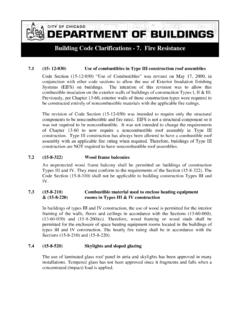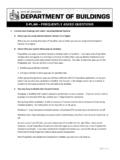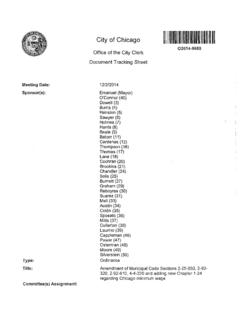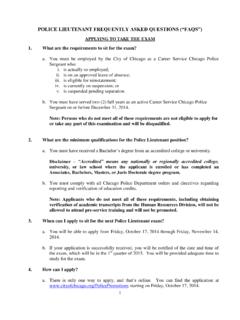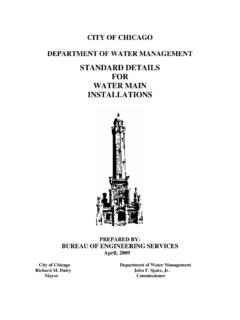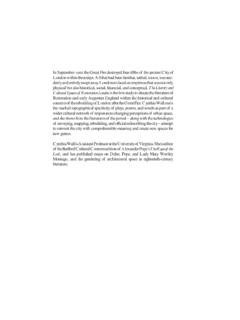Transcription of HISTORY OF THE CHICAGO FIRE DEPARTMENT
1 HISTORY OF THE CHICAGO fire DEPARTMENT HISTORY OF THE CHICAGO fire DEPARTMENT CHICAGO was nothing more than a little frontier village during its beginning days with roughly six frame buildings and a population estimated at one hundred and fifty. The first building erected in 1831 was a tavern. Mark Beaubien was the proprietor and he named his establishment the Sauganash Tavern . Most dwellers lived along the south bank of the CHICAGO River on South Water Street. The city boundaries were Ohio Street on the north, Jefferson on the west, Jackson on the south and on the east it was State Street south of the river; Lake Michigan north of the river.
2 The Sauganash Tavern remained the social center of CHICAGO until March of 1851, at which time a fire caused its closure. The first fire Company was formed in 1832 called the Washington Volunteers . The first CHICAGO ordinance was passed November of 1833, prohibiting the passing of any stove pipe through the roof, partition or siding of any building, unless guarded by tin or iron six inches from the wood . The penalty charge for this infringement was $ Coincidently, if the violation wasn t corrected within 48 hours the penalty was repeated.
3 As a result of this ordinance the first fire Warden named Benjamin Jones was appointed. In September of 1834, CHICAGO was divided into four wards a fire Warden for each. The fire Warden was paid to make monthly inspections to verify compliance, particularly of the stovepipe ordinance. During October of 1834, an individual carrying a shovel of hot coal embers from one building to the next at Lake and LaSalle Street accidentally initiated a fire . The following day an article was printed in the CHICAGO Democrat Newspaper criticizing the city for its lack of competent authority at the fire .
4 Consequently, another ordinance was immediately enacted indicating the Warden presiding in the district of the fire occurrence acts as the Chief in command; the remaining ward Wardens as his assistants. Additionally, a Warden had the jurisdiction to insist bystanders participate in the extinguishment of the fire and if met with opposition a fine of $ was imposed. In November 1835 yet another ordinance was created, however this one was two fold, a storeowner or dwelling occupant was ordered to provide one leather fire water bucket for each fireplace or stove in the building and hung in a conspicuous place.
5 Hence if more than one fireplace or stove that many fire water buckets were expected. Furthermore, the second part to this ordinance was a directive commanding owners and dwellers to go promptly to the scene of a fire with their very own personal fire water bucket, which was identified by the painting of their initials thereon. Of course, a fine was levied for negligence of the bucket ordinance and/or unwillingness to participate at the fire scene. As a direct result of the fire water bucket ordinance the first fire bucket brigade was formed in November of 1835 called fire Guards Bucket Company.
6 Pioneer Hook and Ladder Company No. 1 was organized a month earlier on Rev. 6/10/2004 HdT 1 October 7. Earlier than that even, September the Board of Trustees convinced the town president to place an order for two hand pump fire engines and one thousand feet of hose. A month later additional equipment was ordered: two ladders-sixteen feet long, two fire hooks with chain and rope, four axes, and four handsaws. The town census of 1835 showed a population of 3,265. The rapid building of CHICAGO was done almost entirely of combustible material.
7 The town trustees were stirred to improve the fire DEPARTMENT . Hirman Hugunin, president of the board of trustees, became the Chief Engineer of the fire DEPARTMENT in December of 1835. The first site for Engine Company No. 1, fire King was LaSalle Street where City Hall is now. The dimension of the house was twenty-four by twelve feet in size. With much inducing by the members to place a cistern in the building to hold two hogshead of water, (63 gallons per hogshead) and to be made of good pine lumber the board of trustees agreed.
8 The November ordinance of 1835 insisted on a Chief Engineer, two assistants, and four fire Wardens (in addition to the board trustees who were fire Wardens-ex-officio). This same ordinance empowered the trustees to appoint the members of the DEPARTMENT . George E. Snow succeeded Chief Hugunin and became the second Chief of the fire DEPARTMENT on February 17, 1836. Chosen by a special committee of firefighters and approved by the board of trustees, John M. Turner was appointed Chief Engineer in February 1837. He was foreman of Hook and Ladder Company No.
9 1 and Alvin Calhoun was elected foreman of Engine Company No. 1. On March 4, 1837 CHICAGO was incorporated as a City. According to a special census 4,170 was the population at that time. The City under the first charter was divided into six wards. fire Wardens were members of the City council with power to appoint others and to organize fire companies. A Chief Engineer and two assistants were to be elected annually by the voters of the city. If the voters failed to do so the council appointed the Chief and his assistants.
10 A new second Engine was purchased in the fall of 1837 with the formation of the Tradesman s fire Company in December. The name soon changed to the Metamora Engine Company No. 2 located on Lake Street east of the river. In 1839 Alexander Lloyd was chosen Chief and held the office for one year. Alvin Calhoun was the fifth Chief of the fire DEPARTMENT , serving from 1839 to 1840. The first fire of any significance occurred October 27, 1839 on Lake Street near Dearborn. The fire destroyed the Tremont House and 17 other structures, as well, with damages amounting to $65, September of 1841, the CHICAGO Bag and fire Guard Company better known as The Forty Thieves was formed.
